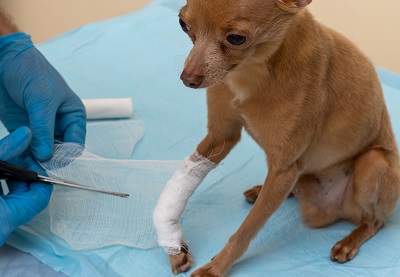During an emergency, time is of the essence. Every minute spent looking for supplies and first aid advice from Dr. Google (there really IS good information out there) delays your ability to assist your pet. To use first aid as an immediate first line of defense, being prepared is critical. When you know what to do and you have the supplies to do it, you can work quickly and effectively, and give your pet the best chances for recovery and survival.
First Aid Kit Supplies Checklist:
Critical Information
- Important phone numbers (e.g., regular veterinarian, closest emergency pet hospital, Pet Poison Helpline, a friend or family member who can help you transport your pet)
- Pet medical records (updated as needed)
- Up-to-date list of your pet’s medication and any drug/dietary allergies
Liquids/Ointments (check expiration dates and replace as needed)
- Hydrogen peroxide 3% (to induce vomiting in cats and dogs; use only as directed by a veterinary professional)
- Milk of Magnesia or activated charcoal (to absorb poison; use only as directed by a veterinary professional)
- Sterile saline solution (can be used for an eyewash or to flush a wound)
- Over-the-counter antibiotic ointment or cream
- Corn syrup or Karo syrup (used in diabetic/hypoglycemia emergencies)
- K-Y Jelly or generic version (to protect wounds or lubricate eyes)
- Baby food that is safe for rabbits/guinea pigs or Oxbow Critical Care and feeding syringe
Wrapping/Bandaging
- Cotton balls or swabs
- Gauze pads
- Gauze roll
- Scissors (blunt ends preferably)
- Stretchy self-adhesive bandages or vet wrap
Other Essentials
- Rectal thermometer (normal cat rectal temperature is 100.5-102.5°F/38.1–39.2°C; for dogs 100.2-103.8°F/37.9–39.9°C; for rabbits 100.5-103.5°F/38.1-39.7°C. For other species, ask your veterinarian about suitable thermometers and ideal temperatures).
- Tweezers (can be used to remove a sliver or insect stinger)
- Clean towels (can be used for restraint, as a supportive sling, or as extra padding during transport)
- Muzzle (to protect yourself from biting. DO NOT attempt to put a muzzle on your pet during a seizure or if you feel it is unsafe to do so. DO NOT muzzle a pet that is vomiting.)
- Microwaveable heat pad/puck (Wrap in a towel or blanket; do not place directly on your pet.)
- Travel carrier for small pets
- Extra leash and collar for dogs without a carrier
This might seem like a long shopping list, but you likely already have many of these supplies in your human first aid kit (if you don’t already have one, now is a good time to create one.)
It is important to understand that first aid is not an alternative to veterinary treatment and that some of the supplies you should keep in your pet’s first aid kit should not be administered or used without the advice of a veterinary professional.
Now, you may be wondering when and how you should use the items in your new pet first aid kit. There are so many possible scenarios: bite wounds, poisoning, uncontrolled bleeding, heatstroke, difficulty breathing, collapse, and the possibilities go on. Fortunately, most first aid procedures will be the same in certain types of emergencies. There are SO many helpful resources out there, and yes, even if you search on Dr. Google. Some are species-specific and some focus on specific emergency situations. With so many options available, it’s best to ask your veterinarian to point you in the right direction.
Medical emergencies don’t come with forewarnings – for us or our pets. The best way to handle them is to prepare for them, and now would be a good time to start.

